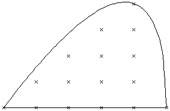Integer points in the plane
How many integer points lie in a region x > 0, y > 0 with x+y <= R? The answer is one of the triangular numbers N(N+1)/2 . If the line x + y = R is replaced by a curved boundary xy = T (the Dirichlet divisor problem) or x^2 + y^2 = R^2 (the Gauss circle problem), then there is no exact formula. The "counting squares" principle says that the number of points is roughly the area. If the number of points is a K-digit number, what proportion of the digits correspond to leading digits in the area? The proportion seems to be about three quarters; it must be at least (about) 50/73. Methods used: approximating the curve by a polygon with rational gradients, exponential sums, the "large sieve" inequality, congruences and divisibility. Another sort of region to consider is a very thin strip alongside a curve y = f(x). Can there be many integer points? Must there be any integer points? Methods used: approximation determinants, congruences and divisibility.


In the diagram the two regions have the same area and they contain the same number of integer points.
Reference
